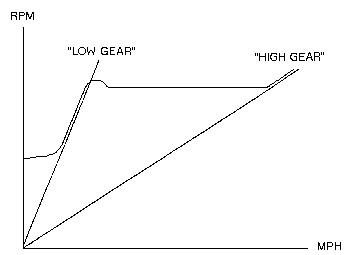http://www.gates.com
- A notched belt is what ties the two clutches together . In case you are wondering what the notches are for, they are so that the belt can bend easier as it goes around the clutches, yet still have adequate surface area on the sides.
- The secondary clutch is the brains of the operation. It limits how far the clutches can shift into high gear.
- For example, if the snowmachine is being operated in deep snow or going uphill, the torque sensing feature of the secondary will overpower the centrifugal forces in the primary and prevent the clutch system from shifting into high gear when the engine does not have enough power.

Image taken from The Gates Rubber Company
http://www.gates.com/
- The above graph shows how a snowmachine clutch shifts. After the initial engagement the clutches stay in low gear until the engine is producing enough power (at a high enough rpm) to overcome the secondary's torque sensing cam. Then the clutches shift so that a constant rpm is held until the clutches can shift no further (called "shift out"). From here on up to terminal speed the rpm/speed ratio is a linear change.
- This means that it is important to match the clutch springs and
helix to the horsepower of the engine.

Image taken from http://www.snowest.com/